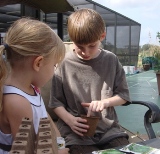I’ve noticed a lot of talk about honey lately… it worries me. If everybody finds out how good it is, there won’t be enough to go around. Then again, that might convince more people to keep their own bees and that would be a great thing. I just can’t fathom the thought of a world without honey…or bees.
Grayson and I love honey. We know that it never spoils, so we continue to collect different kinds. Our honey collection makes us proud. We love to try honey from different places. We usually reserve our local honey for everyday use and keep the “foreign” honey for tasting. Honey does not need to be stored in the refrigerator.
One of our local BASF members, Tom Allen, is an entymologist that has dedicated his life to preserving wildlife. Not only is his honey delicious (honey on the left in the above picture), but his wildlife artwork makes my jaw hit the ground. Check out his website to see for yourself.

My mom's honey from the bees that took up residence in an exterior wall of her house, "Chateau GiGi".

Organic honey from the Zambezi River in Zambia, Africa. The honey on the top is a "raw" honey with a piece of the comb inside (it tastes like creamed honey).
The honey in the above picture is in a bowl with water. It creates a moat to keep the ants out of the honey. It doesn’t bother me too much that the ants want it. I’ve decided to use the ants as a gauge to decide if a sweetener is good for us. My experience is that the ants will not go near apartame, saccharin, xylitol, sucralose, or stevia. The ants go to great lengths to get to the honey though. I’m sticking with them. Maybe they know something we don’t.
The honey that is clearly missing from the pictures is tupelo honey. It is the best tasting honey on the planet. I have ordered it from L.L. Lanier & Sons for the past 10 years. It doesn’t stay in the house long… it’s that good. Tupelo honey is a very unique honey from the tupelo gum tree. It has a low sucrose percentage which has allowed some diabetics to have it.
Chinese honey is probably the only honey we won’t knowingly buy or eat. China is the world’s top honey producer. They use sneaky ways to undercut the U.S. honey market. They use chemicals that keep their bees healthy , but those chemicals end up in the honey. These chemicals have been banned for use with bees in the U.S. and Europe.
A great book for learning more about bees and honey (and a great read) is Robbing the Bees: A Biography of Honey–The Sweet Liquid Gold that Seduced the World, by Holley Bishop. Some bee books for kids are The Life and Times of the Honey Bee by Charles Micucci, The Lifecycle of the Honeybee and Hooray for Beekeeping by Bobbie Kalman.
NOVA has a great website about bees with some incredibly interesting and fun facts.
Many commercial beekeepers don’t keep bees for honey these days. They would never be able to make ends meet in the honey business. Most commercial beekeepers keep their bees to pollinate crops. We have a local beekeeper with over 10,000 hives. He trucks thousands of his hives from Florida to California each year to pollinate almond trees.
Come grow with us!











